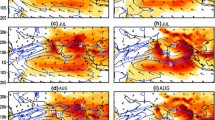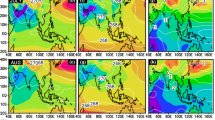Abstract
The present study addresses the depiction of regional features in the National Centers for Environmental Prediction (NCEP) Global Forecast System (GFS) real-time products associated with the onset of Indian summer monsoon 2006 along the west coast of India. This study attempts to understand some atmospheric dynamical processes that give rise to the northward shifting of the convergence zones in the sub-daily scale leading to the onset over Mumbai. The comparison of analysis and forecast shows that NCEP GFS appears to follow the analysis till 24 h, but deviates thereafter. The most notable feature in analyses is the distinct meridional asymmetries in the vorticity field with respect to the convection center. It is identified that the equivalent barotropic structure of vorticity north of the convection center is the main forcing for the northward movement of convergence zones. The composite meridional–vertical structure of each term in the vorticity budget reveals the importance of convective term in the upper atmosphere (700–200 hPa) and the stretching term in the lower atmosphere (1,000–700 hPa) with a lesser contribution of the tilting term. From an analysis of a simplified vorticity equation by retaining these dominant terms and by comparing the evolution of the diabatic heating, it is concluded that the inaccuracies in the model’s representation of convection led to the weakening of barotropic westerlies in the forecast.












Similar content being viewed by others
References
Barker DM, Huang W, Guo Y-R, Bourgeois AJ, Xiao QN (2004) A three dimensional variational data assimilation system for MM5: implementation and initial results. Mon Weather Rev 132:897–914
Daggupaty SM, Sikka DR (1977) On the vorticity budget and vertical velocity distribution associated with the life cycle of a monsoon depression. J Atmos Sci 34:773–792
Douglas MW (1992) Structure and dynamics of two monsoon depressions. Part II: Vorticity and heat budgets. Mon Weather Rev 120:1548–1564
Drbohlav HK-L, Wang B (2005) Mechanism of the northward propagating Intraseasonal oscillations: insight from a zonally symmetric model. J Clim 18:952–972
Holton JR (2004) An introduction to dynamic meteorology, 4th edn. Elsevier/Academic Press, London, p 535
Jayanthi N, Rajeevan M, Srivastava AK, Sunita D, Roy Bhowmik SK, Hatwar HR (2006) Monsoon 2006: a report. India Meteorological Department Monograph No. Synoptic Meteorology No. 4/2006. India Meteorological Department, Pune, p 103
Jiang X, Li T, Wang B (2004) Structure and mechanisms of the northward propagating boreal summer intraseasonal oscillation. J Clim 17:1022–1039
Kemball-Cook S, Wang B (2001) Equatorial waves and air–sea interaction in the boreal summer intraseasonal oscillation. J Clim 14:2923–2942
Krishnamurti TN, Subrahmanyam D (1982) The 30–50 day mode at 850 mb during MONEX. J Atmos Sci 39:2088–2095
Pan H-L, Wu W-S (1995) Implementing a mass flux convection parameterization package for the NMC medium-range forecast model. NMC Office Note, No. 409, p 40
Saha K, Saha S (1988) Thermal budget of a monsoon depression in the Bay of Bengal during FGGE-MONEX 1979. Mon Weather Rev 116:242–254
Tiedtke M (1989) A comprehensive mass flux scheme for cumulus parameterization in large-scale models. Mon Weather Rev 117:1779–1800
Weisman ML, Davis CA (1998) Mechanisms for the generation of mesoscale vortices within Quasi-linear convective systems. J Atmos Sci 55:2603–2622
Weissbluth MJ, Cotton WR (1993) The representations of convection in mesoscale models. Part I: Scheme fabrication and calibration. J Atmos Sci 50:3852–3872
Yanai M, Esbensen S, Chu J (1973) Determination of bulk properties of tropical cloud clusters from large scale heat and moisture budgets. J Atmos Sci 30:611–627
Yasunari T (1979) Cloudiness fluctuations associated with the Northern Hemisphere summer monsoon. J Meteorol Soc Japan 57:227–242
Yokoi S, Satomura T (2006) Mechanisms of the northward movement of submonthly scale vortices over Bay of Bengal during the boreal summer. Mon Weather Rev 134:2251–2265
Zapotocny TH, Jung JA, Marshall JFLE, Treadon RE (2007) A two-season impact study of satellite and In situ data in the NCEP global data assimilation system. Weather Forecasting 22:887–909
Zhang F, Snyder C, Rotunno R (2003) Effects of moist convection on mesoscale predictability. J Atmos Sci 60:1173–1185
Acknowledgments
The authors are thankful to Director Indian Institute of Tropical Meteorology for providing all necessary infrastructural facilities. They would also like to thank the anonymous reviewers for their constructive comments, which improved the quality of the study. The authors wish to thank the National Centers for Environmental Prediction, USA for online access to their Global Forecast System real-time products. The use of daily weather charts and reports published by the India Meteorological Department is acknowledged with thanks. The Grid Analysis and Display System (GrADS) used for preparing diagrams is gratefully acknowledged.
Author information
Authors and Affiliations
Corresponding author
Rights and permissions
About this article
Cite this article
Taraphdar, S., Sanjay, J. & Mukhopadhyay, P. On northward movement of convergence zones along west coast of India in a real-time forecast. Meteorol Atmos Phys 104, 177–189 (2009). https://doi.org/10.1007/s00703-009-0025-8
Received:
Accepted:
Published:
Issue Date:
DOI: https://doi.org/10.1007/s00703-009-0025-8




